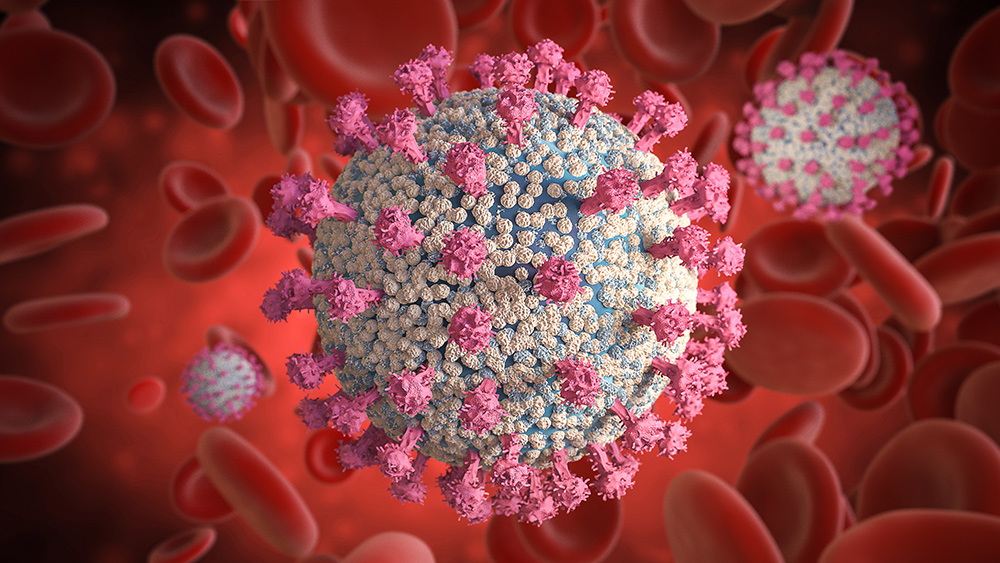Hyping the next plandemic: Researchers in Nebraska develop vaccine targeting all flu strains
05/19/2025 / By Ramon Tomey

- Scientists at the University of Nebraska-Lincoln (UNL) have created an experimental Epigraph vaccine using computational modeling, designed to target multiple influenza strains (including H1N1 swine flu, bird flu and seasonal flu) with potential cross-species protection in pigs, birds and humans.
- In swine trials, the vaccine provided immunity against 12 flu strains, outperforming existing vaccines. Researchers hope it could lead to a long-lasting universal flu vaccine, preventing viral evolution in pigs – a key “mixing vessel” for zoonotic transmission.
- Unlike traditional vaccines that target mutable surface proteins, Epigraph analyzes over 6,000 historic flu strains to identify stable immune-triggering markers (epitopes), aiming for broader and more durable protection.
- Critics warn of potential drawbacks, including ineffectiveness against future mutations, immune suppression, and safety concerns. They point to past vaccine failures like the 1976 swine flu campaign, which was halted due to rare side effects.
- With influenza A causing significant annual deaths and pigs flagged as a potential source of dangerous bird flu mutations, the NIH- and USDA-funded research seeks to preempt outbreaks. However, debates persist over balancing innovation with safety, amid parallels to COVID-19 vaccine rollouts.
Scientists at the University of Nebraska-Lincoln (UNL) have developed a single vaccine that targets multiple strains of influenza – including swine flu, bird flu and seasonal flu – fueling concerns that the next plandemic is on the horizon.
The experimental vaccine, designed using advanced computational modeling, has shown promise in protecting pigs against diverse influenza A viruses. The researchers have also expressed optimism that the injection will protect birds and humans from these pathogens. But skeptics warn that such vaccines may carry unforeseen dangers, including immune suppression and failure against mutated strains.
In a study published late last month in Nature Communications, the UNL researchers detailed how the Epigraph vaccine – named after the software used to design it – outperformed existing commercial vaccines in swine trials. Pigs vaccinated with Epigraph developed robust immunity against 12 different flu strains – including the H1N1 virus responsible for the 2009 swine flu pandemic. The H1N1 strain infected a quarter of the global population and killed over half a million people.
Dr. Eric Weaver, the study’s lead author, called the findings a critical step toward a universal flu vaccine that could last a decade or longer. “If we can prevent influenza in swine, we can cut off the virus’s evolutionary advantage,” he added. According to Weaver, also the director of the Nebraska Center for Virology at UNL, pigs often act as a “mixing vessel” for dangerous zoonotic jumps between birds and humans.
Is the Epigraph flu injection a Trojan horse for the next plandemic?
The Epigraph vaccine was developed after researchers analyzed over 6,000 influenza strains from the past century to identify common viral markers (epitopes) that trigger immune responses. Unlike traditional vaccines, which target rapidly mutating surface proteins, targeting these epitopes could lead to broader, longer-lasting protection.
Weaver’s team is now testing a dual H1/H3 variant vaccine, with hopes of eventual human trials. However, no timeline has been set for public availability.
Despite the optimism, critics argue that such vaccines may be ineffective against future mutations or even weaken natural immunity. Others, meanwhile, argue that such vaccines and their rollout under government-backed vaccination programs prioritize profit over safety.
Historical context supports caution. Past flu vaccines have sometimes offered limited protection, and the 1976 swine flu debacle saw mass vaccinations halted after rare neurological side effects emerged. (Related: The flu vaccine paradox: Are we making things worse?)
The stakes are high; influenza A infects up to 15 percent of humans annually, with H1 and H3 subtypes causing thousands of deaths. The European Union recently flagged pigs as a potential catalyst for a deadly bird flu mutation transmissible to humans. Weaver’s research, funded by the National Institutes of Health and the U.S. Department of Agriculture, aims to preempt such crises.
“We’re on the precipice of a third wave of vaccines – lifelong and universal,” he said. But as with all medical breakthroughs, the balance between innovation and risk remains delicate. Vaccines like Epigraph may cause more harm than good, as they undermine the body’s natural immunity.
One cannot help but notice, however, that the news of Epigraph’s supposed “promise” comes amid reports of the flu virus “jumping from animals to humans.” This same pattern was observed during the Wuhan coronavirus (COVID-19) pandemic. But sooner or later, people may see Epigraph become ubiquitous amid this new “plandemic” in the same manner as the mRNA vaccines.
FluShot.news has more similar stories.
Watch Jefferey Jaxen and Del Bigtree talking about a study that shows getting the flu vaccine increases one’s chances of catching influenza.
This video is from The HighWire with Del Bigtree channel on Brighteon.com.
More related stories:
FDA halts annual flu strain selection meeting, signaling an end to seasonal flu vaccine FRAUD.
DEADLY FLU JAB WARNING: New flu vaccines make recipients 27 PERCENT MORE LIKELY to catch the flu.
Sources include:
Submit a correction >>
Tagged Under:
Big Pharma, bird flu, conspiracy, Epigraph, Flu shots, flu strains, future science, H1 strain, H3 strain, infections, influenza, Influenza A, insanity, outbreak, pandemic, pharmaceutical fraud, plague, research, University of Nebraska-Lincoln, vaccine wars, vaccines
This article may contain statements that reflect the opinion of the author
RECENT NEWS & ARTICLES
Vaccines.News is a fact-based public education website published by Vaccines News Features, LLC.
All content copyright © 2018 by Vaccines News Features, LLC.
Contact Us with Tips or Corrections
All trademarks, registered trademarks and servicemarks mentioned on this site are the property of their respective owners.




















